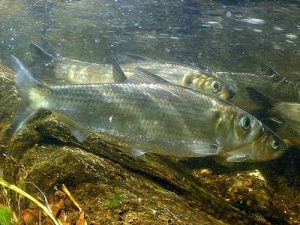
The Bloede Dam Removal, one of the most important dam removal projects in the Mid-Atlantic is officially complete.
In July 2019, project partners announced that the Bloede Dam removal and river restoration is finished.
A significant portion of the Patapsco River now flows freely through Patapsco Valley State Park.
The former Bloede Dam was breached with explosives in September 2018. After 18 months, crews have completed all construction work, including dam demolition, replacing portions of both Baltimore and Howard county sanitary sewer lines, and rebuilding the Grist Mill Trail.
This area of the park re-opened just in time for the busy summer season. The dam’s removal also benefits local communities by improving public safety and by opening the river to recreational opportunities like fishing, swimming, canoeing, and kayaking.
The derelict, concrete dam once threatened public safety; there have been at least nine dam-related deaths since the 1980s.
In addition to eliminating the public safety risk, dam removal gives a tremendous boost to the health of the river ecosystem, including fisheries critical to the food web of the Chesapeake Bay.
Bloede Dam was the first barrier on the Patapsco River blocking migratory fish swimming to and from the Bay. Its removal is the linchpin of a decades-long restoration effort that included the removal of Simkins Dam (2010) and Union Dam (2010).
Removal of Bloede Dam restores to the river and its tributaries more than 65 miles of spawning habitat for blueback herring, alewife, American shad, and hickory shad in the watershed, and more than 183 miles for American eel.
Removal of Bloede Dam was made possible through a partnership of American Rivers, Maryland Department of Natural Resources (including the Maryland Biological Stream Survey, Maryland Geological Survey, Maryland Park Service, and others); Maryland Department of Transportation State Highway Administration, National Oceanic and Atmospheric Administration, U.S. Fish and Wildlife Service, the Friends of the Patapsco Valley State Park, as well as monitoring partners U.S. Geological Survey and University of Maryland Baltimore County.
sources: NOAA Fisheries, Maryland Department of Natural Resources
Leave a Reply
You must be logged in to post a comment.